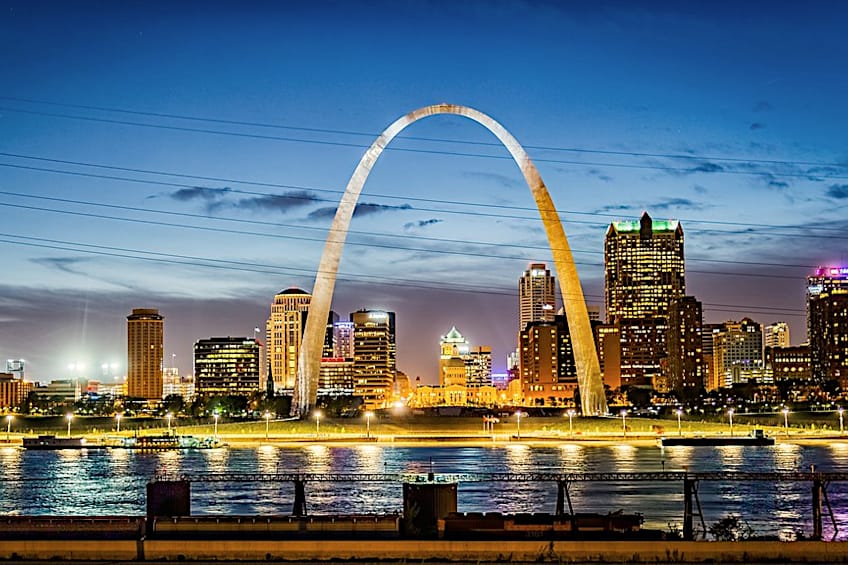Gateway Arch – St Louis’ Controversial Gateway to the West
The Gateway Arch, which is a positively gigantic, curved steel arch in St Louis, is a magnificent sight with an interesting, and rather lengthy, history to learn. If you want to know where the arch is located in St Louis, the Gateway Arch’s history over the years, the St Louis Arch’s height and other dimensions, and when the St Louis arch was built in the first place, keep reading. There’s much to learn!
A Look at the Gateway Arch
| Architect | Eero Saarinen |
| Date Constructed | 1963 – 1965 |
| Function | Commemoration of American Westward Expansion |
| Location | St Louis, Missouri, United States |
The arch in St Louis is one of the most famous arches in the modern world, and it has a long and varied history full of difficult bureaucracy. The arch in St Louis, which is technically called the Gateway Arch, or “The Gateway to the West,” is a huge stainless-steel arch that curves high above the city skyline for all to see. The arch in St Louis finished construction in 1965 and was then dedicated to the westward expansion of the United States and was even dedicated to “the American people.”
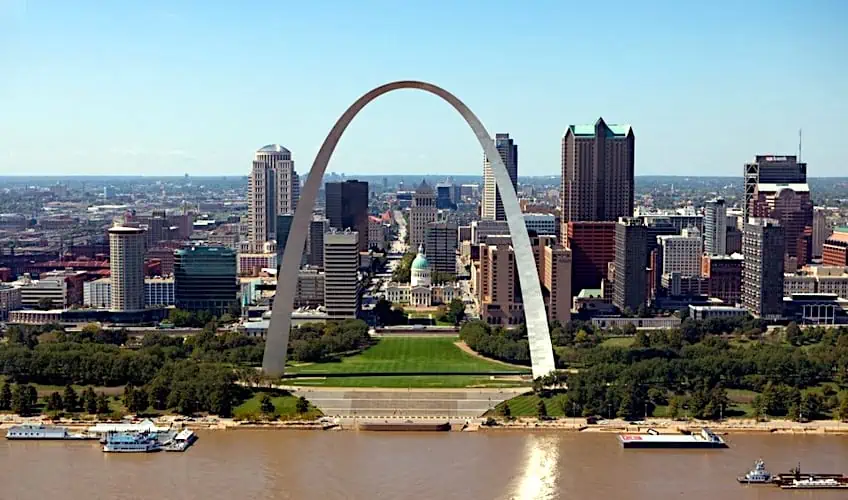
The Gateway Arch is one of the most famous in the world and is instantly recognizable to so many. The weighted catenary arch, which is also the tallest arch in the world and possibly the tallest monument in the Western world too, attracts over 4 million visitors a year. Of those 4 million, a quarter of them goes all the way to the top of the monument. Did we mention that? Oh yes, the Gateway Arch isn’t just an arch in St Louis that happens to be large, but it’s also a structure that can be ascended so that all visitors can gaze down at the nearby Mississippi River or the city itself.
The Gateway Arch has even become an official National Historic Landmark, and it achieved this status on 2 June 1987. The arch in St Louis is a symbol for that city the same way the Eiffel Tower is a symbol for Paris. It would likely look strange to see aerial photography of the place from before it was constructed because, well, wasn’t that monument always there?
Sadly, it wasn’t always there, but if you want to learn the answers to a few questions, like: when was the St Louis arch built, where the arch located, what is the St Louis arch’s height and width, and the general Gateway Arch history, then stick around and have a read.
When Was the St Louis Arch Built?
You may want to know the answer to the following question: when was the St Louis arch built? To ask this is to ask a much larger question about the bureaucracy that went into the construction of this iconic arch. However, for the sake of simplicity, and because it will be discussed when we discuss the Gateway Arch history, it will likely be best to say that it was constructed from 12 February 1963 to 28 October 1965.
The earliest initiator of the project was civic leader Luther Ely Smith who proposed constructing a memorial on the St Louis riverfront to revitalize the city’s shattered economy in 1933.
Even at this early stage, the intention of such a monument would be to celebrate the pioneers, leaders and explorers who made the Westward expansion of the United States possible. The majority of the city’s inhabitants felt that such a massive expenditure was not justified, and as a result, it would be many decades before the development of the area would commence.

You may think that because of these dates that it was designed shortly before construction started, but the architect who designed the arch in St Louis, a man named Eero Saarinen, actually designed it all the way back in 1947. The absolute political nightmare that led to the Gateway Arch’s construction is quite a history to behold.
In addition, the Gateway Arch may have been completed in 1965, but it was only opened to the public on 10 June 1967 after costing about $13 million (which is equal to about $86.5 million in 2021 terms). So, just where is the arch located in St Louis?
Where Is the Arch Located?
Judging by the fact that this arch is associated with St Louis, Missouri, it would be obvious to acknowledge that that is where the Gateway Arch is located. However, where exactly is it located? The arch in St Louis is located in the Gateway Arch National Park which is right beside the Mississippi River.
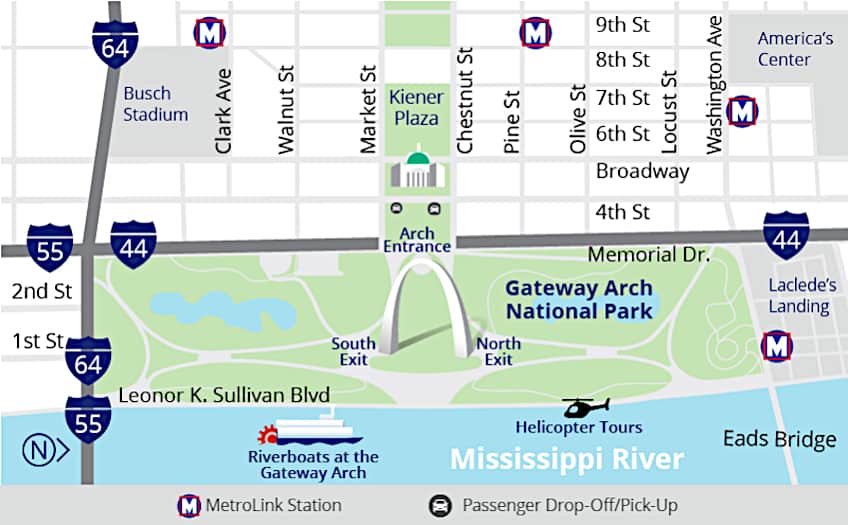
Not only is the Gateway Arch beside the Mississippi River, but it was also built directly on top of a historic 1764 site.
This arch was built where St Louis was originally founded. It was first established right there on the west bank of the Mississippi River, an incredibly important river for the people of every state the river happens to run through, and Missouri is no different. The site was already razed by the early 1940’s, leaving only two historic building standing.
St Louis Arch Height
We all know that the Gateway Arch is tall, but what is the specific St Louis arch height? This is actually something very interesting because the arch in St Louis is 192 m (or 630 ft) tall, but it’s also that wide. The length and width are exactly the same because it was designed as a perfect geometric curve that needed to be built so precisely that if it had been just 1/64th of an inch off, the whole thing would have been a failure as the two sides would never have met up with each other in the center.

The Gateway Arch is made of 142 prefabricated stainless-steel sections, and the monument required a scissors truss during construction to stop the whole thing from falling over. The company that built the arch in St Louis even commented that because the Gateway Arch was curved, it was significantly harder to build than a regular vertical building. After all, a regular building goes straight up and probably won’t topple over during construction.
So, that is one tall arch, and while the St Louis arch height is rather impressive, what’s even more impressive is that the monument is earthquake resistant and can sway a few inches if it needs to. Furthermore, you can take a futuristic-looking tram ride to the top and have a look at the spectacular view from the observation deck.

You may be wondering about the previously mentioned Gateway Arch history that was such a bureaucratic nightmare. Well, why did the Gateway Arch have such a difficult history?
Gateway Arch History
Back in the 1930s, there was an idea in St Louis. A few people thought it would be good to find some way to stimulate the economy by reviving the somewhat dilapidated waterfront in the city. However, there wasn’t much support for this plan as it was in the middle of the Great Depression and people weren’t very excited to spend much money on an expensive project like this.

The Politics of the Gateway Arch
Those who wanted it done were persistent though. There was the expectation that the project would create 5000 jobs over the next 3 to 4 years, but that never happened. It instead made less than 100, but we’re getting ahead of ourselves. The Gateway Arch started as an attempt to stimulate the economy in some way, and Roosevelt’s New Deal was in full swing. So, the president approved the creation of this monument through executive order proclaiming the establishment of the Jefferson National Expansion Memorial.
Once the executive order was in place, the construction did not start. Instead, the old waterfront needed to be condemned and demolished. This involved the demolition of various historic buildings, although two were kept in some capacity. The Old Cathedral and the Old Rock House survived these purges. Although the Old Rock House was disassembled and then parts of it were lost. So, that didn’t exactly work as expected.

While this was happening, there needed to be some way to design this monument, and it was decided that the best way to do this would be to have an architectural competition for the best submission. The person who ultimately won was Eero Saarinen and his team. His design for the monument was labeled as “inspired” and “happy in its symbolism” by some of the commenters. However, it didn’t receive unanimous approval.
Gilmore D. Clarke was one of those who disapproved of it, and he even unfavorably compared the Gateway Arch design to an arch that Benito Mussolini envisaged. So, the monument was compared to fascism quite early in its development, and this would echo later civil rights issues that were raised.
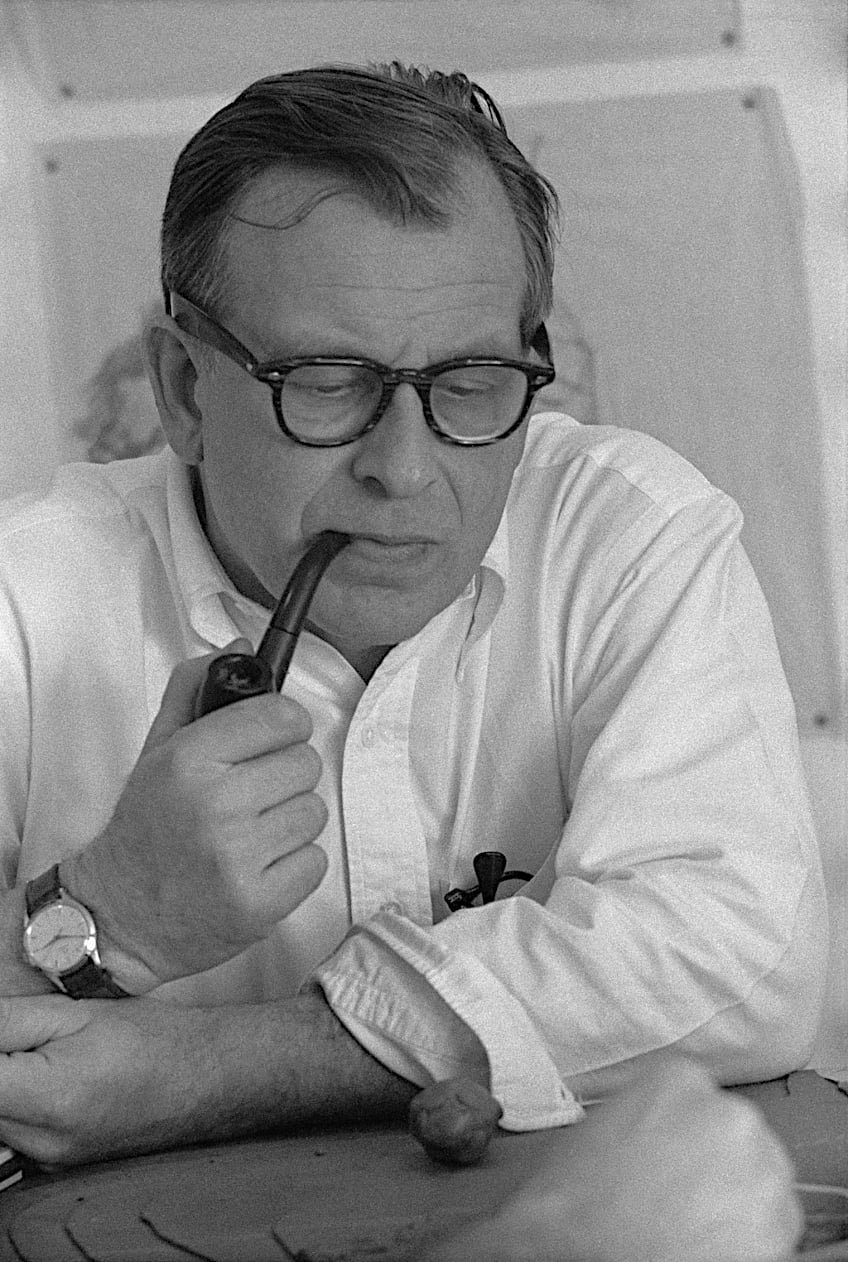
The Construction of the Gateway Arch
Regardless of this, construction went ahead. In preparation for the construction, there were some new laws put in place to limit the size of buildings opposite the Gateway Arch. In addition, over fifty companies were invited to bid for the illustrious task of constructing this years-long project. Ultimately, MacDonald Construction Co., which provided the lowest bid, got the job.
It took a few years to break the ground and prepare the foundation for the rest of the construction. However, only 16 years after the design was decided, the Gateway Arch began construction in 1963.
There were a few predictions that things would not turn out all that well for this large project, and it was projected that workers would die while building the Gateway Arch, but, luckily, no one did. The monument was also beset by various issues that prolonged the construction, such as various safety checks that needed to be done. In addition, there were constant issues with the money needed to build the thing and there were legal problems that rendered the whole affair a bit of a nightmare.
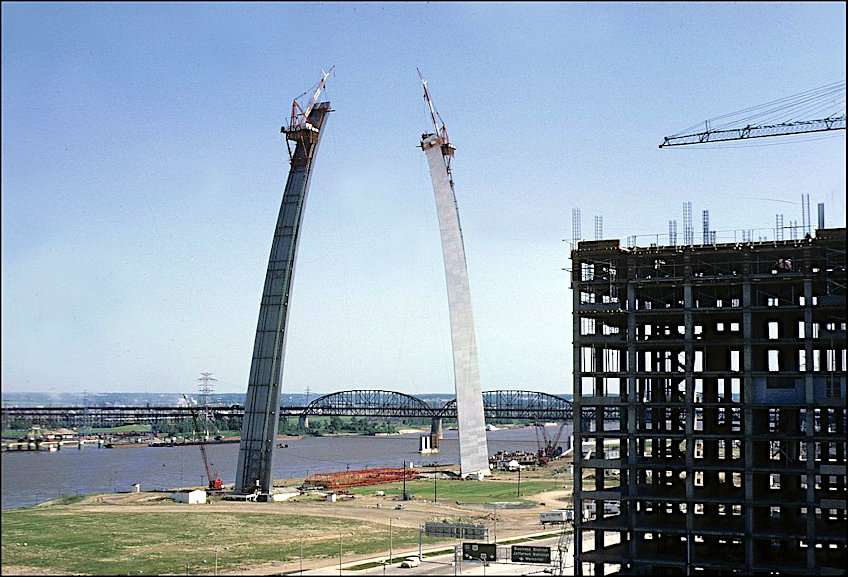
To make matters worse, there were some genuine concerns from civil rights activists at the time who saw the arch in St Louis as a monument to racial discrimination. The westward expansion of the United States, which is what the Gateway Arch is meant to commemorate, is not a particularly clean history. For instance, it has connections to the genocidal history of the United States government’s treatment of the Native Americans, and that history was often used to encourage the acceptance of the American notion of manifest destiny.
In addition, one of the historical events the Jefferson National Expansion Memorial was originally meant to celebrate upon its proclamation in 1935 was the so-called “Dred Scott Decision” of 1857 where the supreme Court decided that US citizenship did not extend to African Americans.
The Gateway Arch was Finally Completed
However, the Gateway Arch was ultimately finished. The workers were forced to overwork near the end of construction, but there was one rather adorable thing that was done right before it was completed. Over 762,000 students and other people provided signatures that were collected and then put into a time capsule. That time capsule was then welded directly into the Gateway Arch’s keystone.

The monument was finally done, and you may expect that there’s nothing left to say about the Gateway Arch history. You’d be wrong if you thought that, because when the structure was complete, Hubert Humphrey, the Vice President under Lyndon B. Johnson, arrived to dedicate the monument. He did do that, but there were supposed to be 250,000 people in attendance. Then it rained. Nature often seems to enjoy raining on supposedly important occasions.
The Gateway Arch Had Some Issues
While the Gateway Arch’s beginnings may have been rocky, the monument did eventually become a major tourist attraction that only occasionally suffered incidents. There were a few times when people got caught in trams or, on 24 March 2011, a hundred people wound up trapped at the top of the arch because the tram doors wouldn’t close. These things happen though.
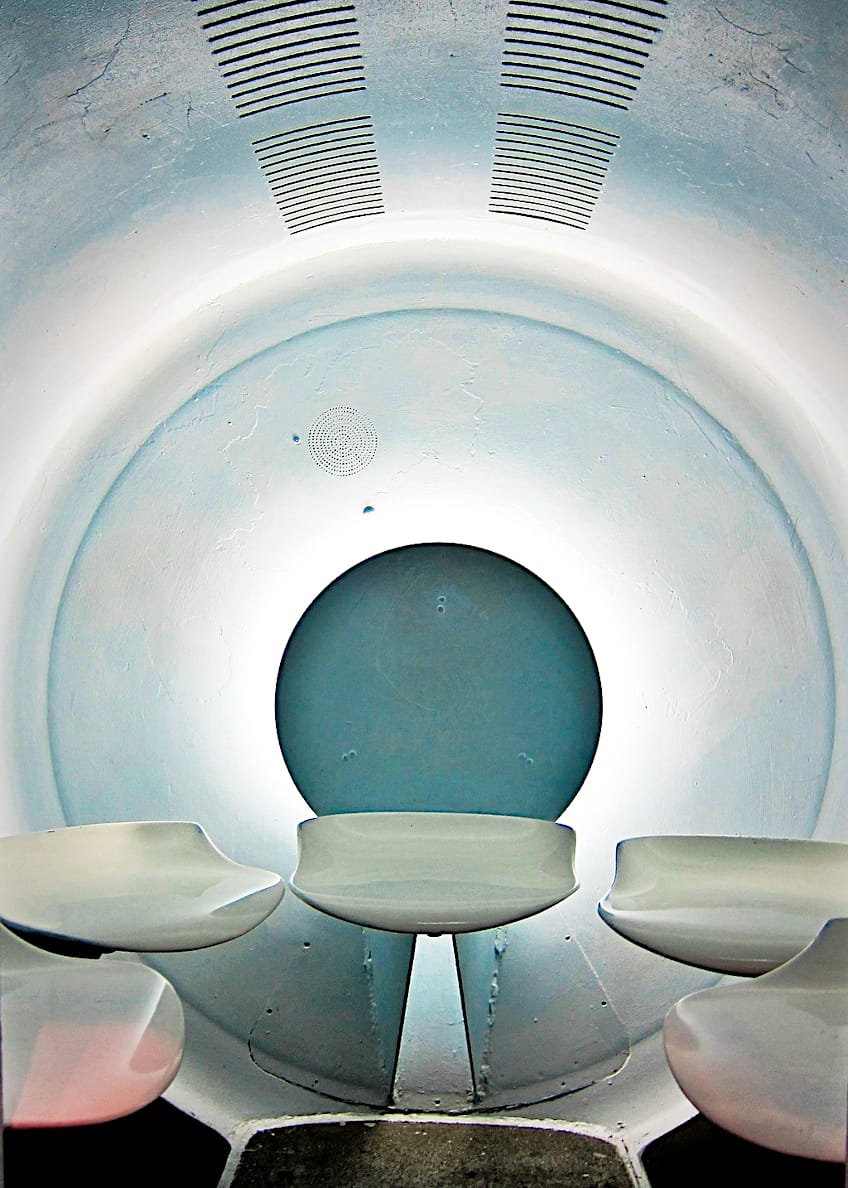
Those kinds of mishaps, over a long enough period of time, will happen, but seeing as the Gateway Arch looks like a pair of giant goalposts, some people decided to try and parachute or do other stunts around/through it. There was even one incident in which a hot air balloon was meant to go under the arch, but instead of doing that, it hit the arch and plummeted to the ground. Thankfully, it was all fine for the occupants of said hot air balloon.
The Gateway Arch Is Open to Tourists
In the modern day, the Gateway Arch has its own museum that has six themed areas that explore various groups. There were areas dedicated to Native Americans, explorers, rebels, and others. In addition, you can take a riverboat cruise alongside the gigantic monument or, as should be quite obvious, you can also climb the Gateway Arch and check out the spectacular view.
The last piece of Gateway Arch history is that while the arch took ages to build and a lot of money too, it also ended up needing to be renovated. That renovation cost more than the original construction.
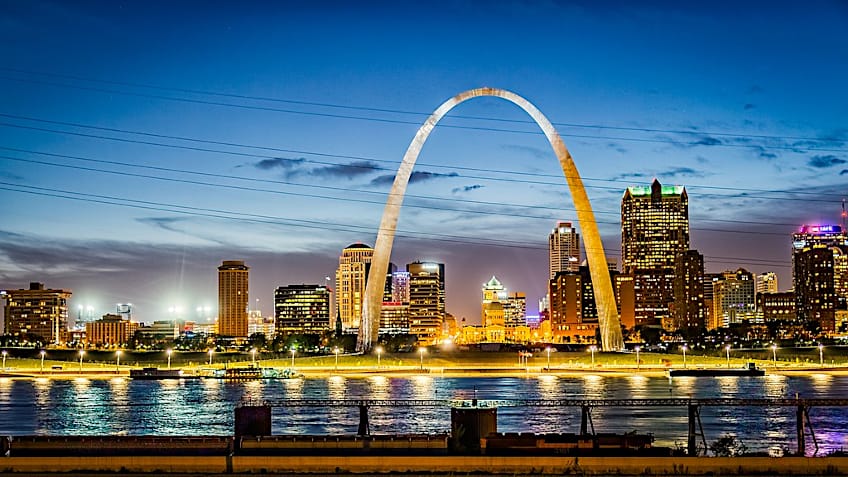
Ultimately, the Gateway Arch keeps going and its history continues. It started life, in a conceptual sense, a decade and a half before it was built. It had a bureaucratic nightmare of an early existence, but has become an indispensable symbol of St Louis. We will have to wait to see what history continues to unfold for it.
Frequently Asked Questions
What Is the Arch in St Louis?
The Gateway Arch is a monumental structure along the Mississippi waterfront. It is made of stainless-steel slabs that are large enough for people to enter the huge monument.
When Was the St Louis Arch Built?
This is a complicated question but, technically, it was built between 1963 to 1965. It was actually designed in 1947 and spent years in the early development phase.
Where Is the Arch Located?
The arch is located beside the Mississippi River in St Louis. The arch is specifically located on the site of the historic founding of the city.
What Is the St Louis Arch’s Height?
The Gateway Arch is 192 m (or 630 ft) tall, but, perhaps more impressively, the arch in St Louis is exactly as wide as it is tall.
Justin van Huyssteen is a writer, academic, and educator from Cape Town, South Africa. He holds a master’s degree in Theory of Literature. His primary focus in this field is the analysis of artistic objects through a number of theoretical lenses. His predominant theoretical areas of interest include narratology and critical theory in general, with a particular focus on animal studies. Other than academia, he is a novelist, game reviewer, and freelance writer. Justin’s preferred architectural movements include the more modern and postmodern types of architecture, such as Bauhaus, Art Nouveau, Art Deco, Brutalist, and Futurist varieties like sustainable architecture. Justin is working for artfilemagazine as an author and content writer since 2022. He is responsible for all blog posts about architecture.
Learn more about Justin van Huyssteen and about us.
Cite this Article
Justin, van Huyssteen, “Gateway Arch – St Louis’ Controversial Gateway to the West.” artfilemagazine – Your Online Art Source. June 15, 2023. URL: https://artfilemagazine.com/gateway-arch/
van Huyssteen, J. (2023, 15 June). Gateway Arch – St Louis’ Controversial Gateway to the West. artfilemagazine – Your Online Art Source. https://artfilemagazine.com/gateway-arch/
van Huyssteen, Justin. “Gateway Arch – St Louis’ Controversial Gateway to the West.” artfilemagazine – Your Online Art Source, June 15, 2023. https://artfilemagazine.com/gateway-arch/.


